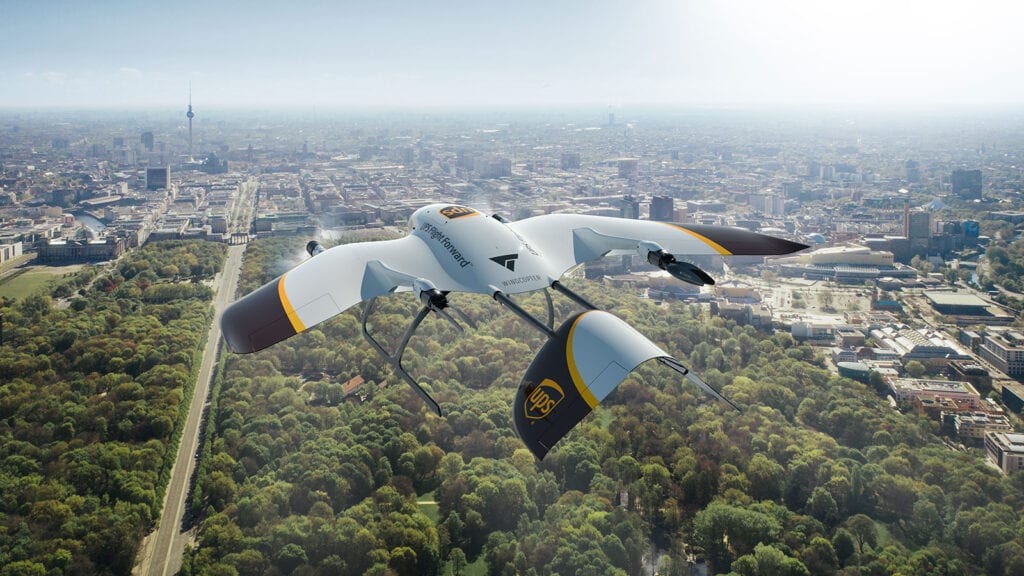
EASA released a proposed special condition for certifying unmanned aircraft intended for use in medium- and high-risk applications, such as drone delivery flights over populated areas. (Wingcopter/UPS)
The European Union Aviation Safety Agency (EASA) released a proposed special condition for certifying unmanned aircraft intended for use in medium- and high-risk applications, such as drone delivery flights over populated areas.
The proposed certification approach, SC-Light UAS, would apply to all drones with a maximum takeoff weight of up to 1,322 pounds (600 kg), not intended to transport humans, and operated either via remote pilot or autonomously — defined as operating without a remote pilot being able to intervene. The special condition is open for public comment until September 30.
The document also applies to drone operations defined as “specific” — the middle of three risk-based categories under the EU’s risk-based framework: open, specific, and certified. Rulemaking on the certified category, likely to include carrying dangerous goods or human passengers, is ongoing.
“This proposal forms part of EASA’s wider initiative to ensure drones can be operated safely and acceptably, particularly in areas which are densely occupied by people and moving or static objects,” EASA Executive Director Patrick Ky said.
The proposed special condition, similar to one released last year for passenger-carrying VTOL aircraft, uses objective airworthiness standards in lieu of a prescriptive approach and takes into account variations in operational risk — an approach that industry has lauded as more fitting for a rapidly-evolving industry segment with wide variation in designs and applications.
“Until today, the certification basis of UAS has been either derived from manned aircraft CS integrated with Special Conditions to address specific UAS aspects, or defined with Special Conditions based on documentation developed and published by JARUS (joint authorities on rulemaking for unmanned air systems),” EASA authors wrote in the special condition. “In both cases the approach has been prescriptive. Objective based CS are deemed more appropriate for UAS.”
Safety objectives for the special condition were calculated based on an assessment of a probable urban scenario in 2035, created by the Single European Sky ATM Research Joint Undertaking (SESAR-JU)’s Drone Outlook Study, taking into account the projected number of flight hours flown by drones in European cities, urban population density, and representative products and operational assumptions.
“With no occupant on-board, the risk inherent to any UAS operation is strictly dependent on the characteristics of the operational volume, and of the adjacent ones which the UA might inadvertently enter,” the special condition states, adding that every UAS certification application will be linked to a detailed definition of operational volume, along with buffers, adjacent volumes, and air and ground risks.
For example, the acceptable quantitative probability of various failure conditions is presented based on population density in the operational area, with higher safety requirements defined for flight “over assemblies of people” rather than “in a populated environment.”

EASA’s SC-Light UAS proposes different safety objectives based on the aircraft’s intended operating environment, (EASA)
The proposed special condition does allow for the use of strategic and impact mitigations as part of the certification process, the former intended to reduce the number of people at risk on the ground and the latter to reduce either the area affected by a crash or the energy transmitted on impact.
In other words, parachutes or energy-absorbing designs will be taken into account when evaluating an unmanned aircraft’s failure conditions — unlike EASA’s means-of-compliance for its special condition for passenger-carrying VTOL aircraft released earlier this year.
“We are thrilled to see that EASA is recognizing the advantage of a whole airframe recovery parachute system and recognized how it can reduce the energy transmitted in a crash to a very low level,” Larry Williams, chief executive officer of ballistic parachute-maker Aviation Safety Resources, told Avionics. “Applying the benefit of a recovery system toward safety objectives as a means of compliance is a logical, time-proven mitigation strategy. ASR is currently working with many OEMs that not only appreciate the importance of an on-board recovery system as a means of compliance but understand the public’s awareness and outright demand for this increased level of safety.”
EASA’s authors note that the SC-Light UAS is based on certification standards produced by JARUS, as well as previous EASA special conditions for remotely piloted aircraft (SC-RPAS) and VTOLs (SC-VTOL).
Michael Blades, vice president of aerospace, defense and security at Frost & Sullivan, told Avionics this document is EASA’s “answer to the Federal Aviation Administration’s Part 23, Amendment 64,” through which the U.S. regulator created flexible, performance-based standards for light aircraft meant to accommodate a wide variety of new designs.
“EASA points out that these standards are for the specific category and not the certified category, which likely means there will be even stricter standards to conduct certain operations,” Blades wrote in an email. “This looks good for cargo UAS operations, in my opinion, because it seems they will require less strict standards — rightfully so — than passenger-carrying UAS.”
German drone manufacturer Wingcopter, which has partnered with Astral Aerial, UPS and others on delivery pilot projects, spoke favorably to Avionics of the proposed special condition, though the company is still formulating its official comments for EASA.
“We highly appreciate the pace the EASA is moving forward to establish an adequate rule set for UAS,” said Richard Boden, head of certification for Wingcopter. “The proposed SC Light UAS is an important step in this direction and will help all UAS manufacturers to get more clarity about for product certification requirements and lays the basis for future developments. We are in close collaboration with the EASA as well as with other market stakeholders and associations to support the development and finalisation of this proposed Special Condition as well as the development of further upcoming standards.”